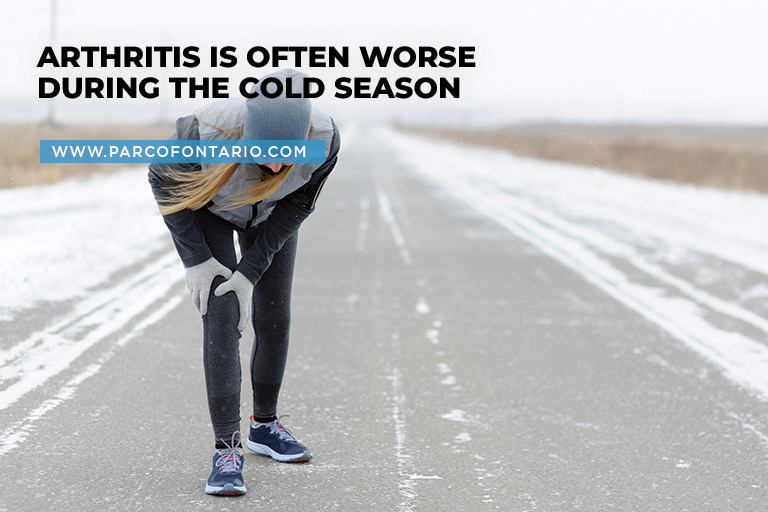
Text Neck: Causes, Symptoms, and Prevention
Many of us spend long hours hunching over our electronic mobile devices and laptops. As we spend more time texting, browsing social media, and reading on our devices, this constant downward gaze…
Read More
Joint pain affects people of all ages and backgrounds, posing a widespread health issue. Whether from injury, arthritis, or other causes, it profoundly affects quality of life. But have you ever wondered why joint pain is prevalent during the cold weather?
In this article, we delve into the potential correlation between changes in weather and joint pain, exploring the factors that contribute to this complex relationship and offering insights into effective management strategies, including seeking treatment from a professional chiropractor in Scarborough.
Joint pain refers to discomfort, soreness, or inflammation affecting any part of the body’s joints, including knees, hips, shoulders, and wrists. It can arise from various causes, including:
The prevalence of joint pain is widespread, with millions of Canadians experiencing its effects on a daily basis.
Managing joint pain is essential for maintaining mobility, independence, and overall well-being. Chronic pain can significantly impact daily activities, leading to decreased productivity and diminished quality of life. Understanding the factors that contribute to joint pain, including environmental influences like weather changes, is crucial for effective management and treatment.

Research examining the effects of weather on joint discomfort has yielded mixed results. While some studies suggest a correlation between specific weather conditions and increased joint pain, others have found inconclusive evidence. Common theories explaining how weather influences joint pain include:
Cold weather may cause muscles, tendons, and ligaments to tighten, exacerbating joint stiffness and discomfort. Conversely, warm temperatures may promote relaxation and improved circulation, reducing pain and inflammation.
High humidity can increase swelling and inflammation in joints, leading to heightened pain sensitivity and discomfort, particularly in individuals with arthritis or other inflammatory conditions.
Fluctuations in barometric pressure may affect joint fluid, potentially aggravating existing joint pain and inflammation. Changes in atmospheric pressure can also impact nerve endings and pain receptors, contributing to increased pain perception.
The impact of weather on joint inflammation can vary depending on individual sensitivities and underlying health conditions. While some individuals report increased discomfort during cold, damp weather, others may experience relief in warmer, drier climates. Understanding these nuances is essential for developing personalized management strategies tailored to individual needs.
Joint pain sensitivity to atmospheric changes may vary in individuals. Some may experience heightened joint pain and discomfort during specific atmospheric changes. Factors contributing to weather sensitivity include:
Older adults may be more susceptible to weather-related joint pain due to changes in cartilage and joint structure, as well as a decline in tissue elasticity and resilience.
Chronic conditions like arthritis and fibromyalgia can amplify sensitivity to weather changes, exacerbating joint symptoms and reducing overall quality of life.
Some individuals may inherit genetic factors that influence their response to environmental stimuli, including weather variations. Genetic markers associated with inflammation and pain perception may contribute to increased susceptibility to weather-related joint discomfort.
Arthritis, a common cause of joint pain, affects millions of Canadians, contributing to stiffness, swelling, and reduced mobility. Weather sensitivity is particularly prevalent among arthritis sufferers, with many individuals reporting increased pain during cold, wet weather. Understanding the interplay between arthritis symptoms and weather fluctuations is essential for effective symptom management and improved quality of life.
Managing weather-related joint pain requires a multi-faceted approach that addresses lifestyle factors, environmental influences, and individual sensitivities. Effective coping strategies include:
Engaging in regular exercise, maintaining a healthy weight, and adopting ergonomic practices can help alleviate joint pain and stiffness. Physical activity promotes joint flexibility and strength, while weight management reduces stress on weight-bearing joints.
Applying heat or cold therapy, practicing relaxation techniques, and using assistive devices can provide temporary relief during weather fluctuations. Heat therapy helps relax muscles and increase blood flow to the affected area, while cold therapy reduces inflammation and numbs pain receptors.
Exploring complementary therapies, such as chiropractic care, acupuncture, and massage therapy, can offer natural pain relief and improve overall joint function. These holistic modalities address underlying imbalances in the body, promoting healing and restoration of joint health.

Healthcare professionals emphasize the importance of personalized treatment plans and proactive management strategies for individuals experiencing weather-related joint pain. Recommendations for patients include:
The relationship between weather changes and joint pain is a complex phenomenon that varies among individuals. While research continues to explore the mechanisms underlying this correlation, it is clear that weather sensitivity can significantly impact joint health and overall well-being. By understanding the factors that contribute to weather-related joint pain and implementing proactive management strategies, individuals can improve symptom control and enjoy a better quality of life.
If you’re experiencing weather-related joint pain, contact us at (905) 579-9938 to schedule an appointment with a chiropractor in Scarborough and take the first step toward natural pain relief and improved joint function.